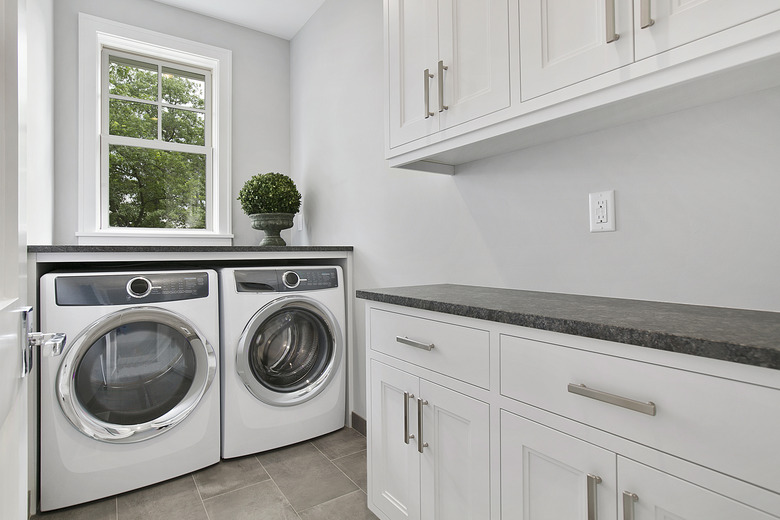How To Find Out If You Have An Electric Or Gas Dryer Hookup
We may receive a commission on purchases made from links.
These days, it's so easy to order stuff online — even big stuff like clothes washers and dryers — that people often do it without being sure of what they need. When it comes to dryers, failure to check your hookups could mean you get a product delivered to your door that you can't use, and you have to return it and get the right one. That's a lot easier to do with a shirt that's the wrong size than a dryer with the wrong connections.
Knowing which dryer hookups you have also makes it easier to take advantage of garage sales and neighborhood giveaways. You might come across a gas dryer for sale that's ridiculously cheap — or even free — but it won't do you much good if your house isn't equipped for it. All it takes is a quick glance at the wall behind your dryer alcove to determine if you have an electric dryer hookup or a gas dryer connection.
Identifying a Gas Dryer Connection
Identifying a Gas Dryer Connection
A gas dryer has connections for both gas and electricity. It uses the gas to provide heat for drying, and it uses electricity to run the controls. Like an electric dryer, it also has a vent opening to connect to the dryer to exhaust warm, moist air, and all these hookups are on the back wall of the dryer alcove within easy reach of the dryer.
The gas connection terminates in a valve with a top-mounted handle that can rotate through 90 degrees. If no dryer is hooked up to it and the gas is off, the handle is oriented perpendicular to the valve nozzle.
The electrical hookup for a gas dryer is a standard 120-volt receptacle. It looks no different than any of the other receptacles in your house. In fact, if you wanted to, you could plug a vacuum into it, and the vacuum would work perfectly.
Identifying an Electric Dryer Hookup
Identifying an Electric Dryer Hookup
Electric dryers use electricity to supply heat and to operate the controls, so you won't see a gas hookup in the wall behind the dryer alcove. Instead, you'll find a large electrical receptacle that does not look like a standard receptacle at all. That's because it's a 240-volt receptacle. The dryer needs the extra voltage to supply enough electricity to power its resistive heating elements.
A 240-volt dryer receptacle is usually round, and unlike conventional receptacles, it isn't a duplex, which means there is only one receptacle, not two. Depending on the age of your house and how it's wired, the receptacle may have three slot openings, or it may have four. When it has three, the top or bottom slot has an L-shape and the two others are arranged at 45-degree angles. When it has four, the top or bottom slot has a L shape, the two on the sides are vertical, and the slot opposite the L-shaped one (which is the extra one for the ground connection) is shaped like a dome.
Three- and Four-Pin Electric Dryer Connections
Three- and Four-Pin Electric Dryer Connections
If you correctly determine you need an electric dryer based on identifying your three-pin dryer receptacle, you may find that the dryer you order has a four-pin cord that doesn't fit. This isn't a problem. It just means your receptacle was installed before codes began to require grounding and four-pin connectors, and there's a simple solution.
You need to replace the four-pin cord with one that has only three pins. Although changing a dryer cord isn't difficult, it's best to have an electrician do it, because a small modification will be required to properly ground the appliance. This usually involves bonding the neutral terminal inside the dryer to the ground terminal. Failure to make this modification could render the dryer capable of giving you a shock, so it's worth the expense of hiring an electrician to make sure it's done correctly.
